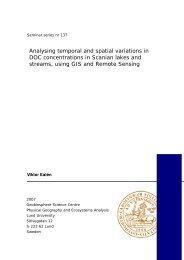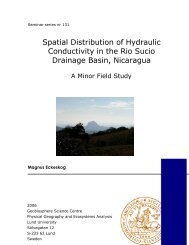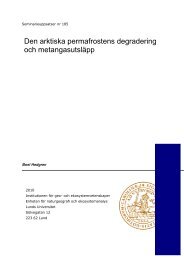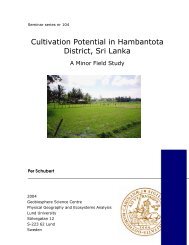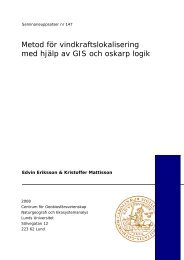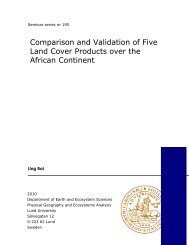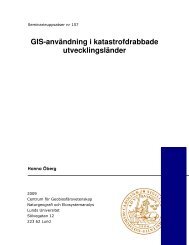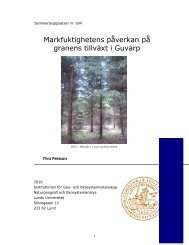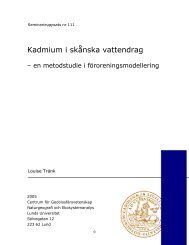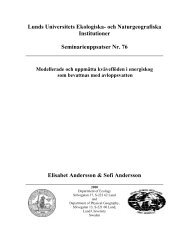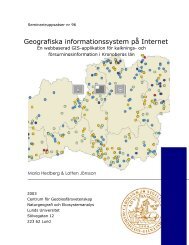Finding Potential Sites for Small-Scale Hydro Power in Uganda: a ...
Finding Potential Sites for Small-Scale Hydro Power in Uganda: a ...
Finding Potential Sites for Small-Scale Hydro Power in Uganda: a ...
You also want an ePaper? Increase the reach of your titles
YUMPU automatically turns print PDFs into web optimized ePapers that Google loves.
2.1.3 TopographyMost of <strong>Uganda</strong> is situated on a plateau, a large expanse that drops gently from about1,500 meters above sea level <strong>in</strong> the south to approximately 900 meters <strong>in</strong> the north.Mounta<strong>in</strong>s and valleys mark the limits of <strong>Uganda</strong>’s plateau region.To the west a natural boundary is composed of the Virunga Mounta<strong>in</strong>s, the RuwenzoriRange, and the Western Rift Valley. The volcanic Virunga Mounta<strong>in</strong>s rise to 4,125 metersat Mount Muhavura and <strong>in</strong>clude Mount Sab<strong>in</strong>io with a height of 3,645 meters, where theborders of <strong>Uganda</strong>, Democratic Republic of the Congo, and Rwanda meet. Furthernorth the Ruwenzori Range rises to 5,115 meters at Margherita Peak, <strong>Uganda</strong>'s highestpo<strong>in</strong>t. Between the Virunga and Ruwenzori mounta<strong>in</strong>s lie Lakes Edward and George.The rest of the boundary is composed of the Western Rift Valley, which conta<strong>in</strong>s LakeAlbert and the Albert Nile River.The northeastern border of the plateau is def<strong>in</strong>ed by a str<strong>in</strong>g of volcanic mounta<strong>in</strong>s that<strong>in</strong>clude Mounts Morungole, Moroto, and Kadam, all of which exceed 2,750 meters <strong>in</strong>elevation. The southernmost mounta<strong>in</strong>, Mount Elgon, is also the highest of the cha<strong>in</strong>,reach<strong>in</strong>g 4,321 meters. South and west of these mounta<strong>in</strong>s is an eastern extension of theRift Valley, as well as Lake Victoria. To the north the plateau is marked on the Sudaneseborder by the Imatong Mounta<strong>in</strong>s, with an elevation of about 1,800 meters(Encyclopaedia Britannica, 1992).2.1.4 VegetationVegetation is densest <strong>in</strong> the south and typically becomes wooded savannah <strong>in</strong> central andnorthern <strong>Uganda</strong>. Where conditions are less favourable, dry acacia woodland, tropicalAfrican shrubs or trees and euphorbia occur <strong>in</strong>terspersed with grassland. Similarcomponents are found <strong>in</strong> the vegetation of the Rift Valley floors. The steppes andthickets of the northeast represent the driest regions of <strong>Uganda</strong>. In the Lake Victoriaregion and the western highlands, <strong>for</strong>est cover<strong>in</strong>g has been replaced by elephant grassand <strong>for</strong>est remnants because of human <strong>in</strong>cursions. The medium-elevation <strong>for</strong>ests conta<strong>in</strong>a rich variety of species. The mounta<strong>in</strong> ra<strong>in</strong> <strong>for</strong>ests of Mount Elgon and the RuwenzoriRange occur above 1,800 meters followed by transitional zones of mixed bamboo and2tree heath and mounta<strong>in</strong> moorland. <strong>Uganda</strong>'s 14,500 km of swamplands <strong>in</strong>clude bothpapyrus and seasonal, grassy swamp (Encyclopaedia Britannica, 1992)9



